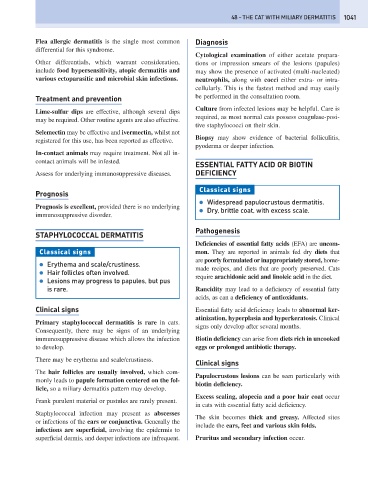Page 1049 - Problem-Based Feline Medicine
P. 1049
48 – THE CAT WITH MILIARY DERMATITIS 1041
Flea allergic dermatitis is the single most common Diagnosis
differential for this syndrome.
Cytological examination of either acetate prepara-
Other differentials, which warrant consideration, tions or impression smears of the lesions (papules)
include food hypersensitivity, atopic dermatitis and may show the presence of activated (multi-nucleated)
various ectoparasitic and microbial skin infections. neutrophils, along with cocci either extra- or intra-
cellularly. This is the fastest method and may easily
Treatment and prevention be performed in the consultation room.
Culture from infected lesions may be helpful. Care is
Lime-sulfur dips are effective, although several dips
required, as most normal cats possess coagulase-posi-
may be required. Other routine agents are also effective.
tive staphylococci on their skin.
Selemectin may be effective and ivermectin, whilst not
Biopsy may show evidence of bacterial folliculitis,
registered for this use, has been reported as effective.
pyoderma or deeper infection.
In-contact animals may require treatment. Not all in-
contact animals will be infested.
ESSENTIAL FATTY ACID OR BIOTIN
Assess for underlying immunosuppressive diseases. DEFICIENCY
Classical signs
Prognosis
● Widespread papulocrustous dermatitis.
Prognosis is excellent, provided there is no underlying
● Dry, brittle coat, with excess scale.
immunosuppressive disorder.
Pathogenesis
STAPHYLOCOCCAL DERMATITIS
Deficiencies of essential fatty acids (EFA) are uncom-
Classical signs mon. They are reported in animals fed dry diets that
are poorly formulated or inappropriately stored, home-
● Erythema and scale/crustiness.
made recipes, and diets that are poorly preserved. Cats
● Hair follicles often involved.
require arachidonic acid and linoleic acid in the diet.
● Lesions may progress to papules, but pus
is rare. Rancidity may lead to a deficiency of essential fatty
acids, as can a deficiency of antioxidants.
Clinical signs Essential fatty acid deficiency leads to abnormal ker-
atinization, hyperplasia and hyperkeratosis. Clinical
Primary staphylococcal dermatitis is rare in cats.
signs only develop after several months.
Consequently, there may be signs of an underlying
immunosuppressive disease which allows the infection Biotin deficiency can arise from diets rich in uncooked
to develop. eggs or prolonged antibiotic therapy.
There may be erythema and scale/crustiness.
Clinical signs
The hair follicles are usually involved, which com-
Papulocrustous lesions can be seen particularly with
monly leads to papule formation centered on the fol-
biotin deficiency.
licle, so a miliary dermatitis pattern may develop.
Excess scaling, alopecia and a poor hair coat occur
Frank purulent material or pustules are rarely present.
in cats with essential fatty acid deficiency.
Staphylococcal infection may present as abscesses
The skin becomes thick and greasy. Affected sites
or infections of the ears or conjunctiva. Generally the
include the ears, feet and various skin folds.
infections are superficial, involving the epidermis to
superficial dermis, and deeper infections are infrequent. Pruritus and secondary infection occur.

